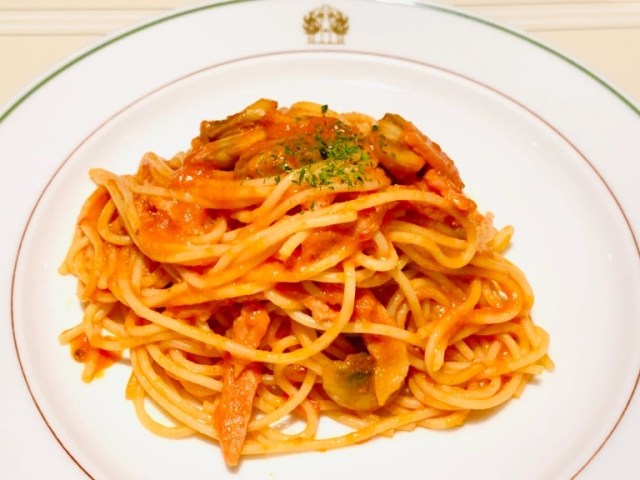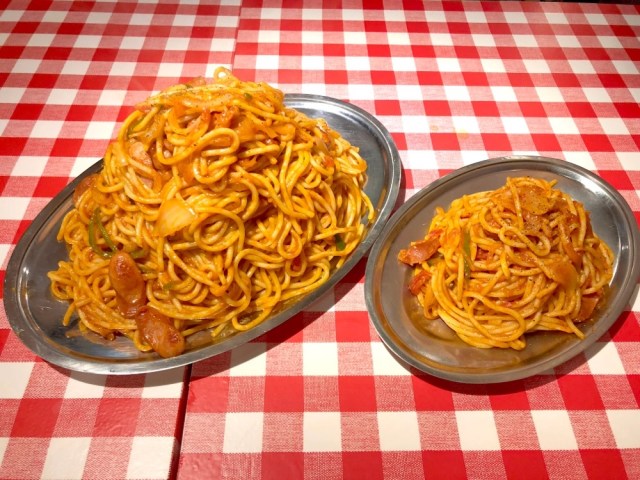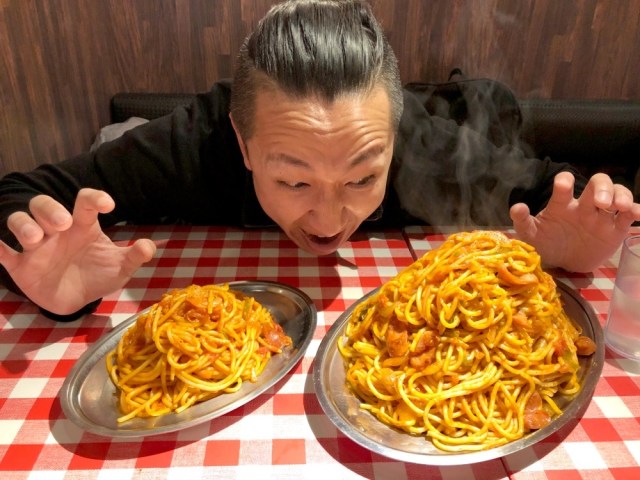
List shows no love for the pasta dish that’s loved by many in Japan.
In recent years, Japan has earned a reputation as one of the very best places on Earth to be if you’re feeling hungry. The modern foodie knows that Japan offers not only amazing sushi, but dozens of delicacies including mouthwatering ramen, wagyu beef, curry rice, okonomiyaki, and far, far too many others to list here.
And yet, Japan also shows up in a recent ranking of the world’s worst foods. This week, English-language food website Taste Atlas updated its 100 Worst-Rated Dishes in the World list, and sitting not too far from the top, at number 24 (i.e. among the lowest-ranked) is Napolitan.
Also known as “Naporitan” (since the Japanese language lacks an L), Taste Atlas rates Napolitan with only 2.5 stars out of 5, and describes it as:
“a combination of overcooked spaghetti, ketchup, onions, green bell peppers, mushrooms, and sausage, ham, or bacon.”
“Overcooked” might have you imagining that Napolitan’s noodles are limp and soggy, but that’s usually not the case. Instead, what Taste Atlas seems to be referring to is that Napolitan is always finished by sauteing all of the ingredients together in a frying pan.
Despite taking its name from Naples, Napolitan was created at Yokohama’s Hotel New Grand during the Allied occupation of Japan following the end of World War II. In those days, the hotel was used as housing for members of the American military, and Napolitan came about as a result of the New Grand’s chefs combining foreign recipes with locally available ingredients and tastes at a time when authentic Italian cuisine had yet to make inroads into Japan’s dining scene.
▼ Two plates of Napolitan
The combination of Napolitan’s ingredients and cooking techniques means that it’s unlike anything you’re likely to be served in Italy or the U.S. There’s nothing too weird about it, but it’s just different enough from pasta in the Western world to feel a little “off,” and that feeling gets amplified by the strong flavors of the dish and how the sauteing seals them in. Tabasco or a similar hot sauce is also a popular added accent, which is yet another flavor that can feel out of place if you’re used to traditional Italian cooking.
Even within Japan, Napolitan is a somewhat divisive dish. As the Japanese palate has become more cosmopolitan and internationalized, more faithful recreations of Italian food as it’s made in Italy, or at least less localized than Napolitan, have become increasingly popular, and you’re unlikely to see Napolitan at dedicated Italian restaurants in Japan, and it’s now considered an old-fashioned dish, something that was a bigger hit with the older generations than the younger ones.
And yet, Napolitan fans aren’t especially rare in Japan either. In addition to dedicated Napolitan specialty restaurants, you can find Napolitan at non-traditional pasta joints (alongside, say, spaghetti with spicy cod roe sauce), and you’ll also see it on menus of casual restaurants that don’t really feature any other pasta or Italian dishes. Its low price and hearty flavors appeal to kids and teens with big appetites and small allowances, and while it’s pretty sure to disappoint anyone who’s got their heart set on spaghetti Bolognese, Napolitan’s unique flavors produce their own specific craving amongst fans.
▼ Fans like our Japanese-language reporter P.K. Sanjun
It’s worth bearing in mind that Taste Atlas’ list of the 100 Worst-Rated Dishes in the World doesn’t include any mention of the methodology used to compile it, so it’s unclear if Napolitan is sitting in 24th place because of the collected voice of worldwide foodies or because of a panel of judges’ personal preferences. Either way, if you decide to try Napolitan for yourself, it’s probably best to think of it as its own entity, separate from other types of pasta, so that you can give it a fair chance of winning you over.
Source: Taste Atlas via Yuruku Yaru
Photos ©SoraNews24
● Want to hear about SoraNews24’s latest articles as soon as they’re published? Follow us on Facebook and Twitter!



 We drink Japan’s spaghetti popsicle (seriously)
We drink Japan’s spaghetti popsicle (seriously) We try Brozer’s ridiculous Tomato Spaghetti Burger because we love carbs and can’t help ourselves
We try Brozer’s ridiculous Tomato Spaghetti Burger because we love carbs and can’t help ourselves Be careful how you talk about “spaghetti” in Japanese — you may sound unhip
Be careful how you talk about “spaghetti” in Japanese — you may sound unhip We try to eat almost 9 pounds of food at a Nagoya spaghetti shop, succumb to the power of carbs
We try to eat almost 9 pounds of food at a Nagoya spaghetti shop, succumb to the power of carbs Mos Burger’s sauce-soaked Wet Burger sure is wet, but is it worth your burger bucks? 【Taste test】
Mos Burger’s sauce-soaked Wet Burger sure is wet, but is it worth your burger bucks? 【Taste test】 Japan’s new difficult-to-drink-from beer glass protects your liver, but it’s a brutal experience
Japan’s new difficult-to-drink-from beer glass protects your liver, but it’s a brutal experience How to order snacks on a Shinkansen bullet train in Japan
How to order snacks on a Shinkansen bullet train in Japan New samurai glasses are Japan’s latest weird must-have souvenir
New samurai glasses are Japan’s latest weird must-have souvenir New Pokémon ice cream, dessert drinks, and cool merch coming to Baskin-Robbins Japan【Pics】
New Pokémon ice cream, dessert drinks, and cool merch coming to Baskin-Robbins Japan【Pics】 Doraemon found buried at sea as scene from 1993 anime becomes real life【Photos】
Doraemon found buried at sea as scene from 1993 anime becomes real life【Photos】 Burger King Japan suddenly adds Dr. Pepper and Dr. Pepper floats to its menu nationwide
Burger King Japan suddenly adds Dr. Pepper and Dr. Pepper floats to its menu nationwide Starbucks Japan welcomes alpacas for cute summer drinkware line【Photos】
Starbucks Japan welcomes alpacas for cute summer drinkware line【Photos】 High-fashion Totoro cuddle purse is like an elegant stroll in the forest【Photos】
High-fashion Totoro cuddle purse is like an elegant stroll in the forest【Photos】 Studio Ghibli hair accessories keep your style tidy with help from Kiki, Moro, Calcifer, and more
Studio Ghibli hair accessories keep your style tidy with help from Kiki, Moro, Calcifer, and more What if Sailor Moon characters were lingerie models? They’d look stunning like this 【Photos】
What if Sailor Moon characters were lingerie models? They’d look stunning like this 【Photos】 Nintendo history you can feel – Super NES, N64, and GameCube controllers become capsule toys
Nintendo history you can feel – Super NES, N64, and GameCube controllers become capsule toys Hello, cosmetics! Clinique teams up with Hello Kitty this summer for first-time collaboration
Hello, cosmetics! Clinique teams up with Hello Kitty this summer for first-time collaboration Demon Slayer: Kimetsu no Yaiba gets new roller coaster attractions and food at Universal Studios Japan
Demon Slayer: Kimetsu no Yaiba gets new roller coaster attractions and food at Universal Studios Japan “The most Delicious Cup Noodle in history” – Japan’s French Cup Noodle wins our heart【Taste test】
“The most Delicious Cup Noodle in history” – Japan’s French Cup Noodle wins our heart【Taste test】 Starbucks releases a cute Frappuccino and Unicorn Cake…but not in Japan
Starbucks releases a cute Frappuccino and Unicorn Cake…but not in Japan Kyoto Tower mascot termination reveals dark side behind cute Japanese characters
Kyoto Tower mascot termination reveals dark side behind cute Japanese characters McDonald’s Japan’s Soft Twist Tower: A phantom ice cream only sold at select branches
McDonald’s Japan’s Soft Twist Tower: A phantom ice cream only sold at select branches Yabai Ramen: What makes this Japanese ramen so dangerous?
Yabai Ramen: What makes this Japanese ramen so dangerous? Finally! Nintendo Japan expands Switch 8-bit controller sales to everybody, Online member or not
Finally! Nintendo Japan expands Switch 8-bit controller sales to everybody, Online member or not Japanese government wants to build luxury resorts in all national parks for foreign tourists
Japanese government wants to build luxury resorts in all national parks for foreign tourists To combat declining birth rate, Japan to begin offering “Breeding Visas” to foreigners
To combat declining birth rate, Japan to begin offering “Breeding Visas” to foreigners 10 things you should buy at 7-Eleven in Japan
10 things you should buy at 7-Eleven in Japan Studio Ghibli releases anime heroine cosplay dresses that are super comfy to wear
Studio Ghibli releases anime heroine cosplay dresses that are super comfy to wear Woman charged for driving suitcase without a license in Osaka
Woman charged for driving suitcase without a license in Osaka Studio Ghibli unveils My Neighbour Totoro miniature house model
Studio Ghibli unveils My Neighbour Totoro miniature house model Kyoto experiencing problems with foreign tourists not paying for bus fares, but not on purpose
Kyoto experiencing problems with foreign tourists not paying for bus fares, but not on purpose Fighting mild hunger with a Japanese soda that turns into jelly in the stomach【Taste test】
Fighting mild hunger with a Japanese soda that turns into jelly in the stomach【Taste test】 Studio Ghibli’s Howl’s Moving Castle tapestry unveiled in Japan for first time
Studio Ghibli’s Howl’s Moving Castle tapestry unveiled in Japan for first time McDonald’s new Happy Meals offer up cute and practical Sanrio lifestyle goods
McDonald’s new Happy Meals offer up cute and practical Sanrio lifestyle goods Sales of Japan’s most convenient train ticket/shopping payment cards suspended indefinitely
Sales of Japan’s most convenient train ticket/shopping payment cards suspended indefinitely Sold-out Studio Ghibli desktop humidifiers are back so Totoro can help you through the dry season
Sold-out Studio Ghibli desktop humidifiers are back so Totoro can help you through the dry season Japanese government to make first change to romanization spelling rules since the 1950s
Japanese government to make first change to romanization spelling rules since the 1950s Foreigner’s request for help in Tokyo makes us sad for the state of society
Foreigner’s request for help in Tokyo makes us sad for the state of society Ghibli founders Toshio Suzuki and Hayao Miyazaki contribute to Japanese whisky Totoro label design
Ghibli founders Toshio Suzuki and Hayao Miyazaki contribute to Japanese whisky Totoro label design Tokyo’s most famous Starbucks is closed
Tokyo’s most famous Starbucks is closed Princesses, fruits, and blacksmiths: Study reveals the 30 most unusual family names in Japan
Princesses, fruits, and blacksmiths: Study reveals the 30 most unusual family names in Japan An Italian take on a Japanese classic, but do people in Japan consider it sushi?
An Italian take on a Japanese classic, but do people in Japan consider it sushi? Ah, isn’t that cute? This rice omelet thinks it’s a corgi!
Ah, isn’t that cute? This rice omelet thinks it’s a corgi! One minute is all you need to make this popular instant noodle meal from Okayama【SoraKitchen】
One minute is all you need to make this popular instant noodle meal from Okayama【SoraKitchen】 Customers simultaneously amused and guilted by the name of this bread stand in Akihabara
Customers simultaneously amused and guilted by the name of this bread stand in Akihabara We find Italian Soba at an Aomori fish market that insisted it’s perfect for the beach
We find Italian Soba at an Aomori fish market that insisted it’s perfect for the beach Super Budget Dining in Japan – What’s the best way to spend 1,000 yen (US$6.70) at Saizeriya?
Super Budget Dining in Japan – What’s the best way to spend 1,000 yen (US$6.70) at Saizeriya? Gari Gari Kun finally releases a delicious specialty flavor frozen snack, we still don’t trust them
Gari Gari Kun finally releases a delicious specialty flavor frozen snack, we still don’t trust them The magical food and gorgeous merch of Tokyo’s brand-new Cardcaptor Sakura cafe and gift shop
The magical food and gorgeous merch of Tokyo’s brand-new Cardcaptor Sakura cafe and gift shop Japanese convenience store pasta called “a monstrosity” by foreigners online
Japanese convenience store pasta called “a monstrosity” by foreigners online In Japan, Uber Eats will deliver the latest manga to your door
In Japan, Uber Eats will deliver the latest manga to your door Japanese plastic food samples abound at this impressive exhibition in Tokyo
Japanese plastic food samples abound at this impressive exhibition in Tokyo Italians taste test Japanese canned coffee and tell us what they think【Video】
Italians taste test Japanese canned coffee and tell us what they think【Video】 Japanese bento shop becomes a hot topic with foreigners on Reddit, but is it any good?
Japanese bento shop becomes a hot topic with foreigners on Reddit, but is it any good? We try to improve the taste of Tabasco jelly beans by putting them on pizza
We try to improve the taste of Tabasco jelly beans by putting them on pizza We try out Pizza Hut Taiwan’s Ramen Pizza, try to figure out its national identity
We try out Pizza Hut Taiwan’s Ramen Pizza, try to figure out its national identity Tokyo’s spicy cod roe ice cream: An unexpected dessert that tastes about like what you’d expect
Tokyo’s spicy cod roe ice cream: An unexpected dessert that tastes about like what you’d expect
Leave a Reply